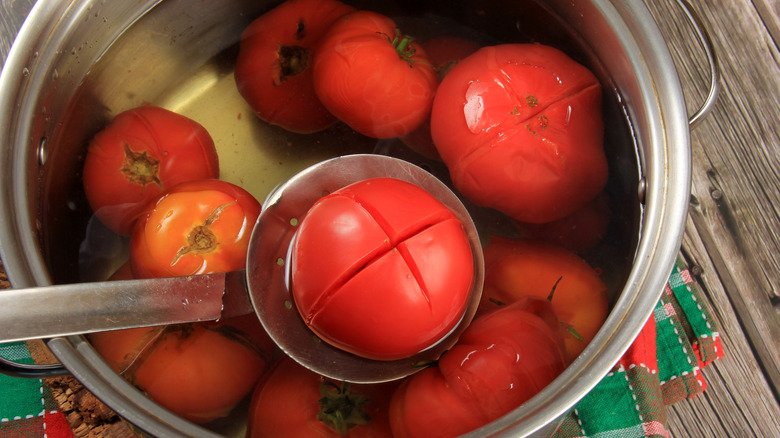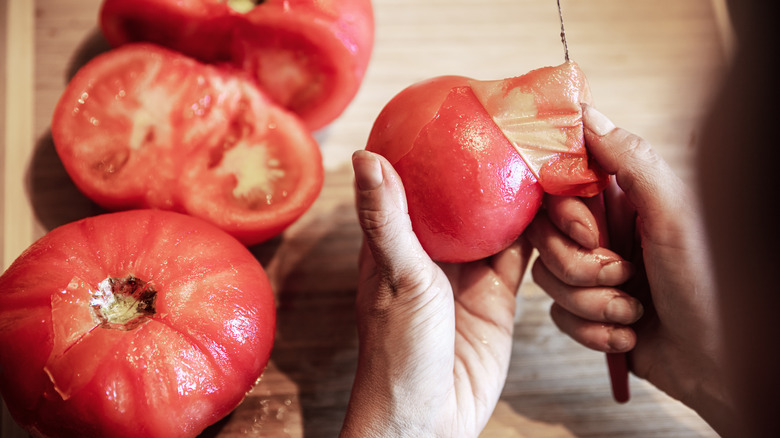José Andrés' 3-Second Trick For Easily Peeling Tomatoes
Tomato season is finally upon us, running from May to October. A can of whole peeled tomatoes is an indispensable product to cook with when the fruit is out of season. But as we transition to plump, juicy farmer's market tomatoes this summer, ditch the can for a fresh, local variety.
There are more than 10,000 varieties of tomatoes, ranging in color, size, shape, water content, thickness of skin, and taste. Depending on its use, each type of tomato lends itself better to a recipe. Beefsteak and heirloom tomatoes are juicy, flavorful late-summer varieties that are best eaten raw to appreciate fully. While plum and Roma tomatoes, such as the gold medal winner San Marzano, are ideal for sauces because they have a low water content, few seeds, and thin skin.
While leaving the skin on a tomato is fine for a salad or BLT sandwich, removing it creates a silkier texture that's better for braises and sauces. In a detailed Instagram video, award-winning chef and World Central Kitchen founder José Andrés and his daughter Carlota share the three-second trick for easily peeling fresh tomatoes. It's all about blanching them before you start peeling the skin.
The blanch-and-shock method
Blanching and shocking the tomatoes requires a little planning. Bring a large pot of water to a boil, and set a large bowl of ice water on the counter nearby. Score an X on the bottom of each tomato, just piercing the skin. Using a spider or slotted spoon, drop a few tomatoes into the boiling water for a count of three before transferring them to the ice water.
Blanching the tomato for only three seconds loosens the skin but keeps the flesh firm, which is ideal for non-cooking recipes, such as fresh tomato salsa or simple gazpacho, where you don't want the tomatoes to turn to mush. If you make a sauce, you can blanch the tomatoes for up to 30 seconds. Do this in batches if you're peeling a lot of tomatoes — you want to keep the water boiling, and adding too many tomatoes at one time will lower the water's temperature. While this method works on all types of tomatoes, stick with plum or Roma for sauces.
Once the tomato has cooled in the ice bath, use your fingers to peel away and discard the skin beginning at the X. Use a paring knife to core the tomato, then dice, squish with your fingers, or purée the fruit for a marinara sauce, creamy tomato soup, or the Israeli breakfast of champions, shakshuka.
The freezer method
For ripened but not wrinkled tomatoes, freezing the fruit allows you to peel them without dirtying more dishes. Although this technique requires more forethought, it's perfect for the end-of-the-season bounty you don't know what to do with, especially the bruised or ugly fruit referred to as "seconds" that markets have trouble moving. These imperfect tomatoes taste as good as the others, and vendors will sell them at a discount. (They aren't always displayed, so ask.)
Simply place whole tomatoes in a freezer bag overnight until frozen. Peel the frozen tomatoes under hot running water, gently rubbing the skin as it loosens around the fruit. If you have more time, allow the tomatoes to thaw, and the skins will slip right off. No boiling or blanching is required.
Although it's the messiest of the three methods, grating tomatoes requires no preplanning, using an old-fashioned box grater over a wide bowl. Coarsely grate the fruit from the bottom to the stem, and the juice, seeds, and flesh will fall into the bowl, leaving the tomato shell behind like the skin suit in "Silence of the Lambs." This technique works best on ripe, but not overly ripe, tomatoes. To prevent grating your fingers, avoid cherry or grape tomatoes and opt for larger varieties.



